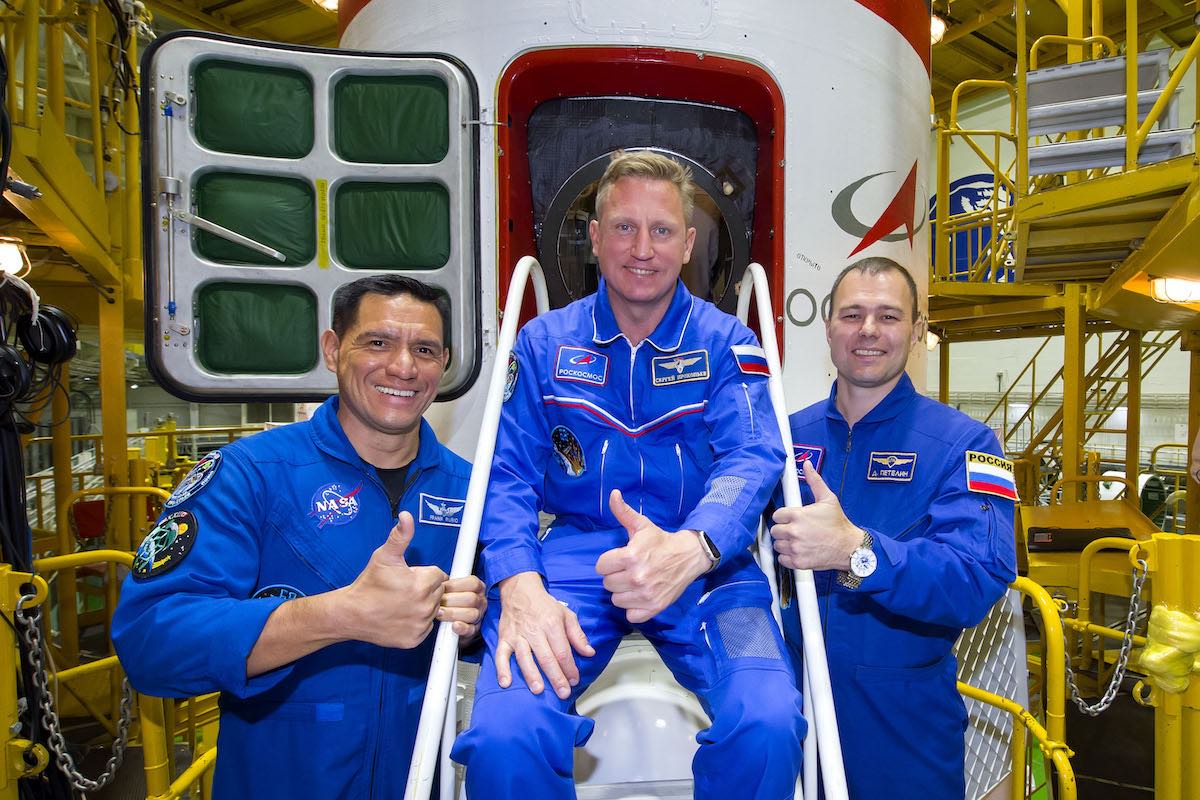
A Russian Soyuz crew ferry docked with the International Space Station spewed particles of an unknown substance, presumably a coolant, into space Wednesday night, forcing two Russian cosmonauts to call off a planned spacewalk as engineers on the ground scrambled to determine the source and the effects of escape.
Mission controllers first observed the leak around 7:45 p.m. EST Wednesday (0045 GMT Thursday), according to Rob Navias, a NASA spokesman who provided commentary on NASA TV. The leak occurred as Russian cosmonauts Sergey Prokopyev and Dmitri Petelin prepared for a spacewalk to help relocate a radiator from outside the Russian Rassvet module to the Nauka science module on the space station.
But before the cosmonauts could get out, Russian ground controllers near Moscow noticed “a significant leak of an unknown substance from the aft portion of the Soyuz MS-22 spacecraft docked to the Rassvet module on the International Space Station,” NASA said in a statement. a short statement. Wednesday night.
Navias said Russian ground teams noticed an audible signal indicating a pressure drop in an external cooling loop on the Soyuz spacecraft when the spray of snow-like particles was first observed escaping from the capsule.
The Soyuz MS-22 spacecraft has been leaking apparent coolant for more than three hours. International Space Station officials are discussing the situation.
The cosmonauts who were preparing for tonight’s spacewalk returned safely to the space station.https://t.co/2lnIsF9yec pic.twitter.com/Sbc6k8iiA2
— SpaceflightNow (@SpaceflightNow) December 15, 2022
There are two collectors in the Soyuz spacecraft’s single cooling circuit, Navias said. It wasn’t immediately clear what impact the apparent coolant leak might have on the performance of the Soyuz spacecraft, which launched Sept. 21 from Kazakhstan’s Baikonur Cosmodrome with Prokopyev, Petelin and NASA astronaut Frank Rubio.
“The spacewalk has been canceled and ground crews in Moscow are evaluating the nature of the fluid and potential impacts on the integrity of the Soyuz spacecraft,” NASA said in a statement.
“The Moscow experts will take a look at their systems and respond to the leak according to their procedures and policies,” said Emily Nelson, NASA flight director at the Johnson Space Center in Houston. “Once they have a good understanding of the final state of Soyuz tonight, we will jointly make a decision on where to move forward from here.”
Navias said there was no danger to the crew from the apparent coolant leak, but officials will need to sort out the condition of the Soyuz MS-22 spacecraft, which is the lifeboat and voyage home for three of the crew members on the International Space Station.
“The best course of action tonight was to focus all our attention, all the attention of our team in Moscow, on clarifying what exactly is going on with the Soyuz spacecraft, and we’ll regroup tomorrow,” Nelson said Wednesday evening.

Russian engineers were also evaluating whether the leak could have been caused by an impact with space junk or a micrometeoroid, or if it could have been triggered by a problem on the Soyuz spacecraft.
The Soyuz MS-22 spacecraft is expected to return to Earth with Prokopyev, Petelin and Rubio on March 28. Until then, the spacecraft will serve as an emergency lifeboat for the three-man crew that was launched aboard in September. If Russian officials determine that the Soyuz MS-22 spacecraft is unable to bring the crew home, a replacement Soyuz could be launched from Baikonur with no one on board automatically docking at the station.
But it’s unclear when the next Soyuz in line, Soyuz MS-23, could be ready for launch. It is currently scheduled to take off on March 16 with Russian cosmonauts Oleg Kononenko, Nikolai Chub and NASA astronaut Loral O’Hara to begin a six-month expedition.
Russian ground controllers instructed cosmonauts on the station’s Russian segment to take close-up photos of the instrumentation and propulsion module on the Soyuz MS-22 spacecraft, the apparent source of the leak.

There are currently seven crew members on the International Space Station. A SpaceX Crew Dragon spacecraft is also docked at the U.S. segment of the outpost after arriving Oct. 6 with NASA astronauts Nicole Mann, Josh Cassada, Japanese astronaut Koichi Wakata and Russian cosmonaut Anna Kikina.
Working from a control panel inside the station, Kikina extended Europe’s robotic arm to inspect the Soyuz MS-22 spacecraft after the leak.
The next SpaceX Crew Dragon mission is scheduled to launch on February 19 from the Kennedy Space Center in Florida with two NASA astronauts, an UAE astronaut and a Russian cosmonaut.
Also attached to the space station are two Russian Progress supply ships and a Northrop Grumman Cygnus freighter.
Email the author.
Follow Stephen Clark on Twitter: @StephenClark1.